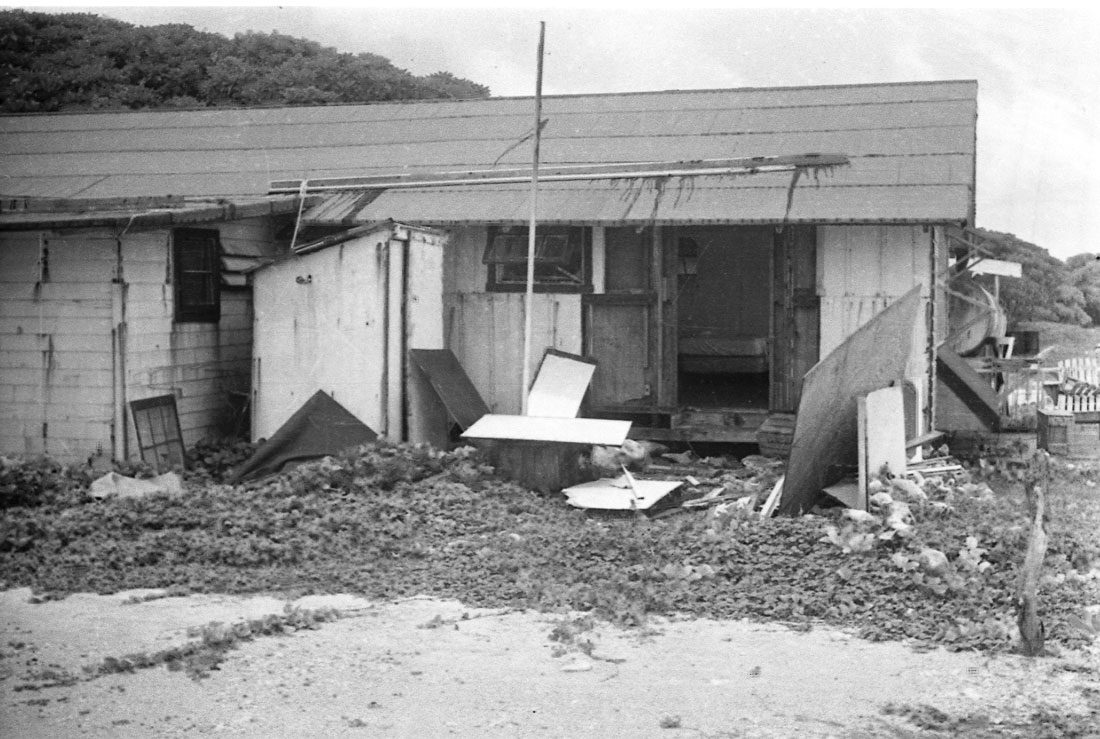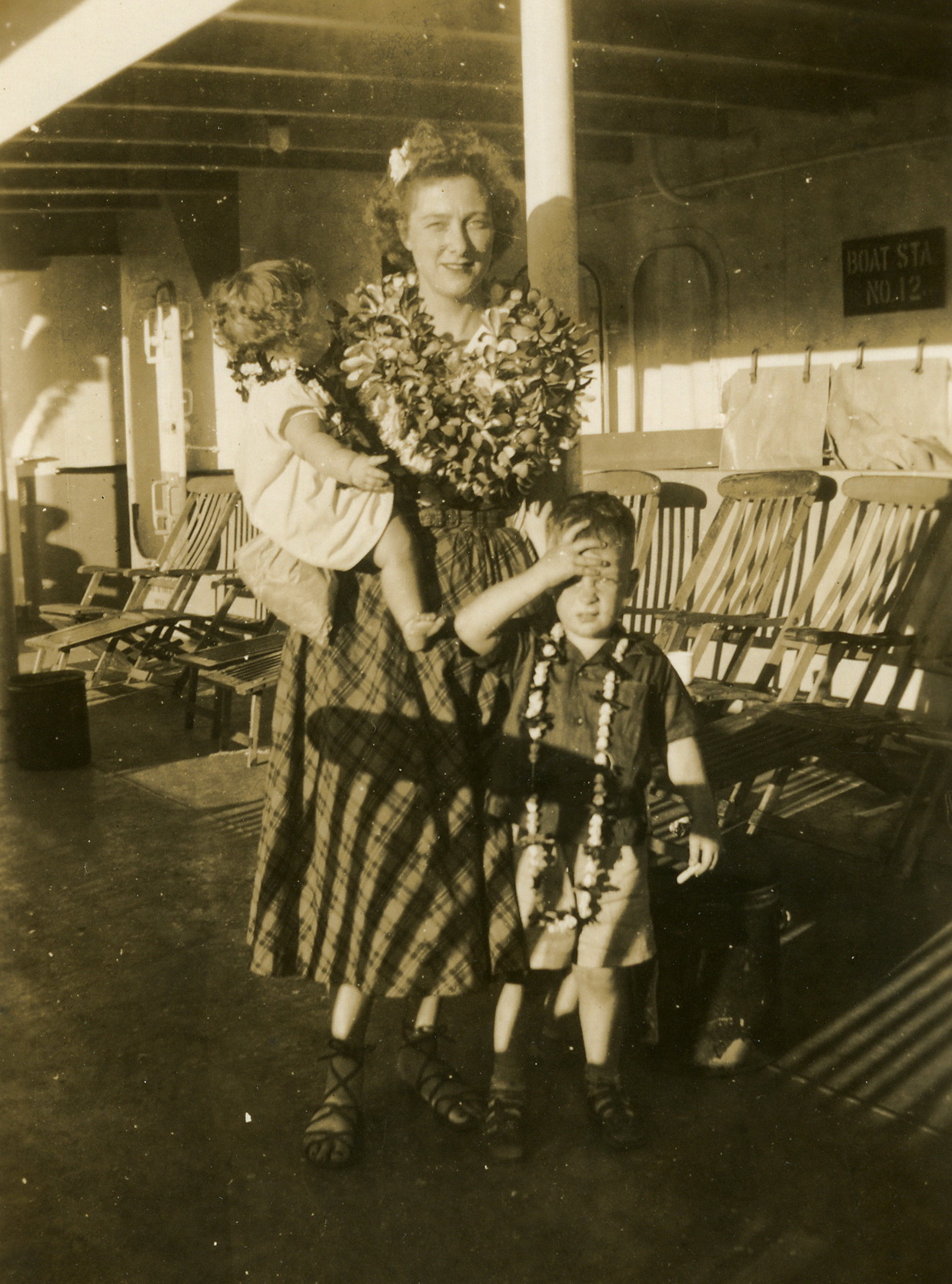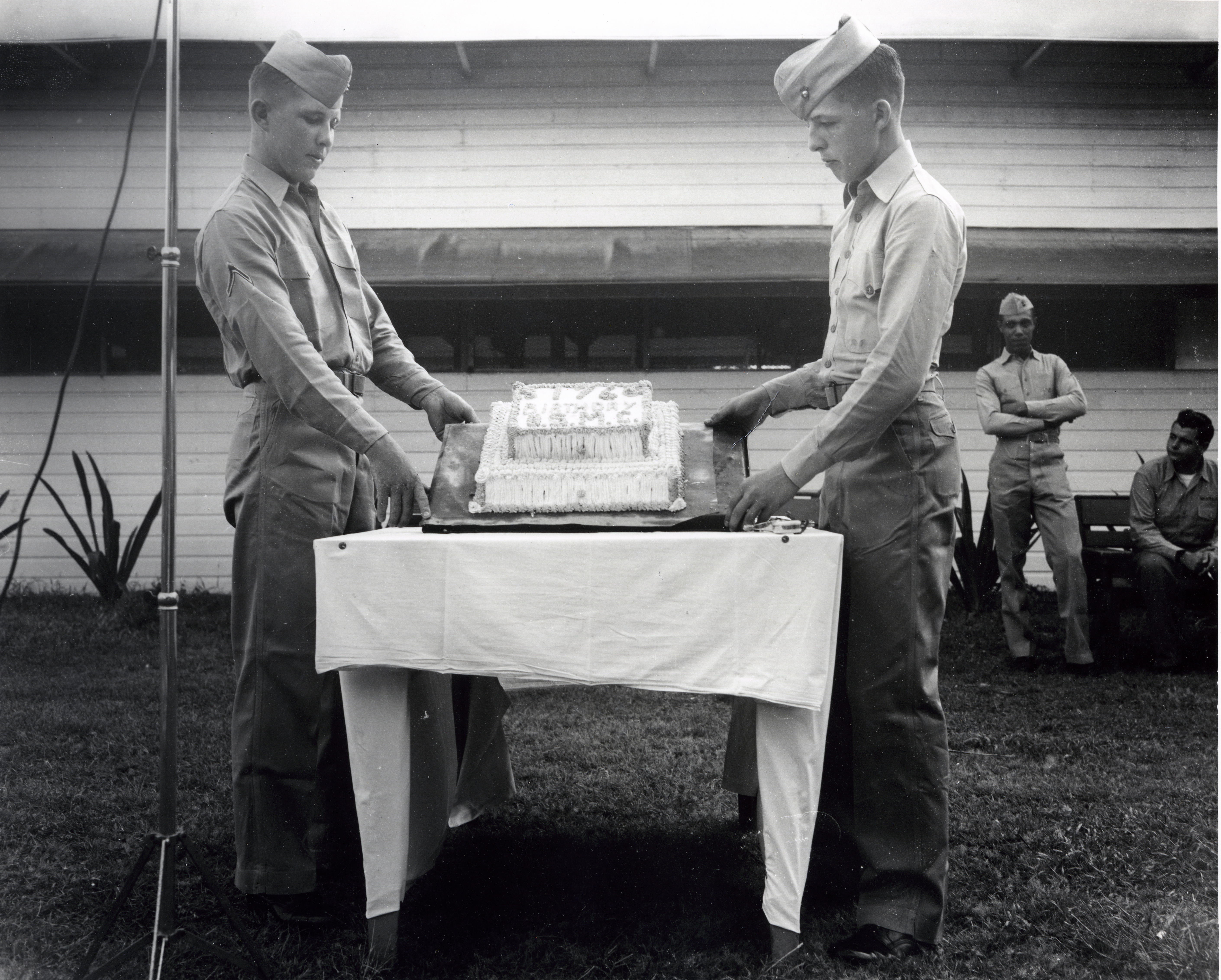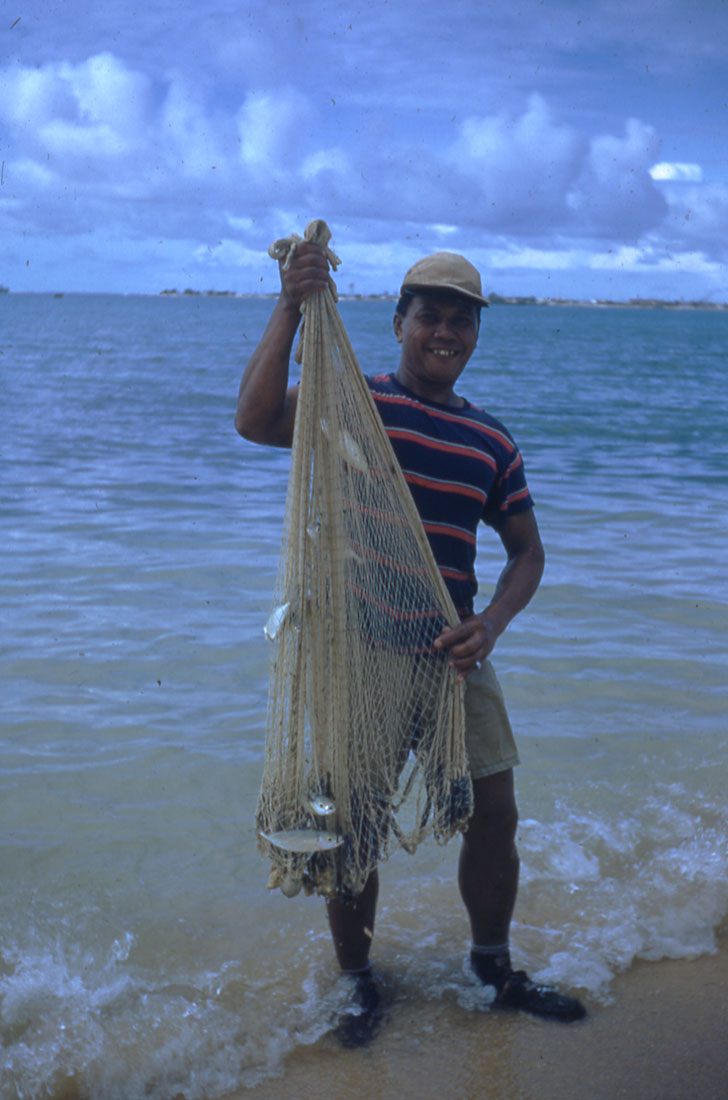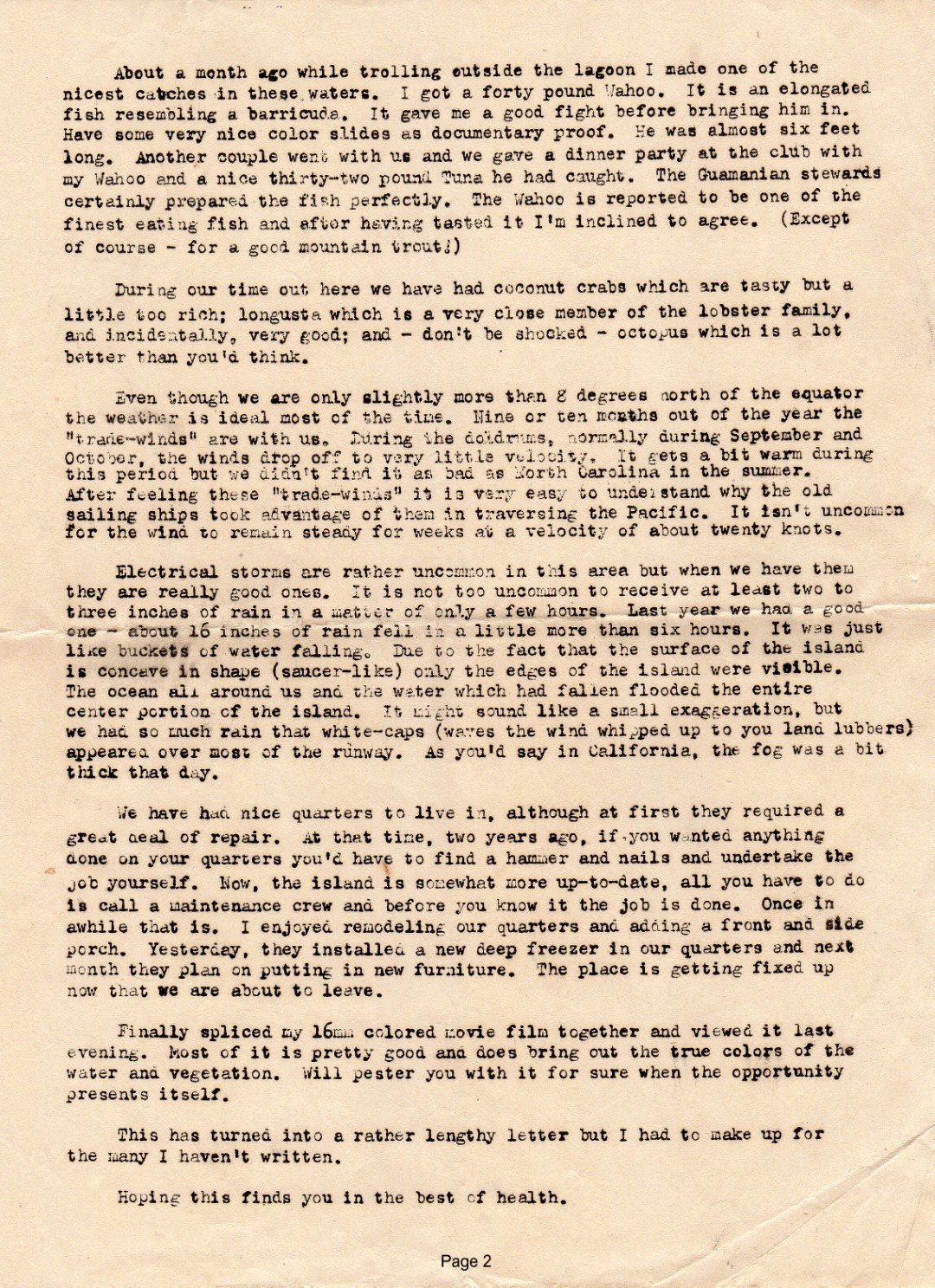RBT's Personal Journal
1950-1952 - Kwajalein - Marshall Islands
1950
I received orders on 9 May, 1950, transferring me to Marine Barracks, Naval Operating Base Kwajalein Island Marshall Islands with departure on 1 June.
Shortly after receiving the news of my transfer we received a letter from Mrs. Durham, the wife of the officer I would be replacing on Kwajalein, welcoming us to the islands. She described living conditions on Kwajalein and very importantly what personal and household items we should carry with us or have shipped. She very thoughtfully described living conditions and social activities including frequent dances at the Navy and Air Force Clubs, as well as private parties. Her letters were very helpful as we found out after arriving on the island.
As I remember it was a frantic month selecting things we needed for our trip, arranging for shipment of extra clothing, household items, etc, we would need on Kwajalein, and arranging for long-term storage of our household things we couldn’t take with us. We somehow worked going away parties, received all of the medical shots each of us needed
It was interesting that our good friends Bob and Kathryn Wycoff with their family were leaving going to Alaska while we were heading for the tropics.
We loaded our little Nash Rambler and with 30 days delay on reporting into San Francisco, we had time to spend a few days with Betty’s parents in Cincinnati and my relatives in Montana as well as some sight seeing. The trunk of the car was loaded as well as the back seat area, which turned out to be a bed for the children because the floor and seat was so packed with our things. As for sightseeing about the only thing of interest on the way to Montana was Mt. Rushmore. As I recall it was only partially finished but was very impressive.
Leaving the valley we had a little trouble with our overloaded car. As we were climbing a very steep hill in a line of traffic everything stopped. Evidently a car ahead of us had vapor lock. When traffic began to move our Nash failed to budge. I waved the traffic behind me to go ahead. When it was clear I backed down the hill and with a running start we made it. Our little Nash had only an 85 plus horsepower engine which, with it being so overloaded, lacked the power to climb from a dead start. It’s funny that that incident stands out so clearly in my memory yet with the exception of having a flat tire in Yellowstone Park, I have no recollection of any other problems for the remainder of the trip.
We stopped briefly in Roundup, Montana to visit my Dad’s sister, Aunt Marion, and Uncle Frank Ottoman, who at that time were Sheriff of Musselshell County. Having written that we would stop by, she had a wonderful meal for us with a beautiful Angel Food Cake for dessert that she always made for me. Betty and I had seen them briefly in 1943 when we were on our way to my joining the USS Nashville, I was always glad we stopped by because it was the only time they saw our son Rob and daughter Susie.
Shortly after leaving Roundup on our way to Lewistown I pointed out to Betty that we were passing thru country where my Grandfather Thompson had his large sheep ranch and I had lived a couple of years as a small boy. It wasn’t an impressive sight as the land was very bare, with only scrawny Willow trees along the creek bed. We saw one large tree near the road as we passed over Flat Willow Creek that I’m sure was the same tree my Dad had told me about called “Thompson’s Lone Pine” or by others, “Hangman’s Tree”. I often wondered of Grandpa’s possible involvement with so many stories of cattle and sheep rustlers and hangings.
Continuing on to Lewistown, the bleak looking land gradually changed to more hospitable terrain of wheat fields and farmland, then over the lows lying hills of the eastern range of the Judith Mountains into Lewistown, nestled between four ranges of mountains forming the Judith Basin. Varying realty from other western towns of wood construction Lewistown had a look of permanence with most office building, schools, hospital and some of the finer homes were constructed of limestone quarried locally and built by Croatian immigrants. The town looked the same to me as it had when I left in 1937, some 13 years earlier.

Martin Dairy Farm [click to enlarge]
Although my parents and sisters had moved from Lewistown, my grandmother Martin still lived on her farm near Lewistown. We had a wonderful visit with it being the first time Grandma had seen Robby and Susie. Grandma was bed ridden but still lived on the farm with Uncle Rolly, Aunt Margaret and Rolly's four boys. Arrangements had been made for us to stay in town with Uncle Pete and Aunt Irene. It was different for Betty to see what the country was like in the summer time from when we stopped by during the war in the winter. We had fun walking and driving around the 900 plus acre ranch seeing the different crops of alfalfa, wheat, etc. Although he was just a little over 3 years old, Robby had a great time with Rolly's boys, varying in age from 7 to 15. They had fun showing him around the farm with all the birds and animals.
The remainder of the trip to Medford, Oregon included seeing Glacier Park and other sites. Shortly after arriving in Medford to visit my sisters, I received a Western Union dispatch canceling my dependents travel, because of the Korean conflict which had just broken out. We arrived in San Francisco a couple days early because of this change, and checked into the Marine Memorial Club, with a room for us and one for my dad, who arranged to meet us. Dad suggested Rob stay with him because our room was so crowded with all of our gear. Rob talked about it for years - that dad would take him out before breakfast to get an “eye opener”. We had a couple nice days to visit before Dad had to leave and I was due to report in.
I reported into the Dept. of Pacific at 1430 18 July 1950 and was advised “to hold myself in readiness to accept any transportation that may become available during the hours of 0800 and 1630 daily”.
The next morning I received a call and was notified that a bus would pick me up at 2:00 pm at the hotel and take me to the Oakland Naval Air Station for departure to Hawaii that evening.
I left Betty and the children in the hotel with no idea of where they would stay or what they would do. A friend of mine, Major Ray Lucked (or Lucile), USMC., the Embarkation Officer at the Marine Headquarters in San Francisco, helped Betty find a rental house in Sharp’s Park, near San Francisco.
Our flight arrived in Hawaii the next morning at 0635 A.M., 20 July. The only interesting thing about the flight was that a Captain in our group missed the bus from the hotel. We all thought he would miss the flight but he showed up at the Air Station, a little tipsy after his last night on the town, not in uniform but regaled in his cowboy outfit, boots, hat and all. Somehow his baggage and uniforms made it to the plane but were unavailable because they were stowed in the hold of the plane. When we reported in to Marine Headquarters, all of us in uniform, except for our Texas cowboy, he received a bit of taking down for not being in uniform. It was my understanding that he had been scheduled to remain in Hawaii as a member of the Marine football team but wound up with an assignment further west.
Kwajalein
After a couple days layover in Honolulu receiving briefings at the Fleet Marine Force (FMF) Headquarters, I departed from Hick am Field for Kwajalein at 1900, 22 July. We landed briefly at Johnson Island for refueling and arrived at Kwajalein at 07:30, 24 July. I have no recollection of seeing the atoll as we approached the island or recall our landing.
Captain Durham met me and we went to the Navy Officers mess for breakfast where I met several officers at that time, including Base Commanding Officer, Captain Cecil B. Gill, USN, who told me he was expecting his replacement any day.
I delivered my pay records to the Navy Disbursing Officer for endorsement. I was advised that upon his departure I would be assigned the quarters occupied by Captain Durham, but until then I would stay in the BOQ (Bachelor Officer’s Quarters).
The next few days before Captain Durham departed we toured the island to get acquainted with the various facilities and meeting the Navy, Air Force and Coast Guard staff officers. The tour of the island didn’t take long to accomplish as the island was only about 1½ miles long and ½ mile wide. The maximum elevation wasn’t more than a few feet. Except for the Marine compound there were only a few scattered trees on the island. It seemed that little or nothing had been done since 1945 to replant trees or remove derelict US and Japanese military equipment.
I assumed command of the Marine Barracks on 31 July 1950, with additional responsibilities as CO of the Navy Brig and Provost Marshall of the island, relieving Captain T.A. Durham, USMC. I also had an additional assignment under the UN Trust Territory of supervising the training of cadets at the Marshallese Constabulary Police Academy on Majuro Island.
I moved into the quarters previously occupied by Captain Durham. The quarters were re-designated as a BOQ (Bachelor Officer’s Quarters), and a Navy Commander, Stan Brent, the Navy Supply Officer, occupied the quarters with me. The building, less than 50 feet from the high-water mark, was a dilapidated framed building built on a cement pad, which originally had been for a Quonset hut. It was old and run down with a leaky roof. There were windows on the side of the front room but none on the ocean side so it was dark and dank inside. The linoleum flooring was cracked, dirty and worn through in many places. The sparse furniture was in a like condition. The refrigerator was dripping rust, inside and out. The water supply was an old causeway pontoon section built on stilts, which caught rainwater run-off from the roof. Even in that condition I was docked my housing allowance.
I believe it was the next week that Rear Admiral Stanhope C. Ring, US Navy arrived. We honored the Admiral aboard with a formal troop formation of Navy officers, sailors and Marine Honor Guard. While inspecting my Marine Guard he asked many questions with one in particular: "How long have you been on the Island?". When he asked me I said ”just two weeks”, He said "Good". It was only a couple of days later the reason for the question became evident.
Following military protocol, I made my formal introductory call that afternoon but was told that the Admiral was very tired and not receiving visitors that evening. I left my Calling card with his aide. The next day at his staff meeting he said he wanted to meet each of us and would have his aide arrange times.
Admiral Ring was a tall, very distinguished looking gentleman. He spoke softly but it was evident his wish was to be taken as a Command, He let us know that facilities on Kwajalein would be upgraded with a significant amount of new construction on a priority basis to support new Atomic operations at Bikini Atoll and air traffic operations in support of the Korean conflict.
As Commanding Officer of the Naval Base, Admiral Ring was my operational boss and my administrative boss was the Commanding General, FMF. PAC. General Lemuel C. Shepard. USMC.
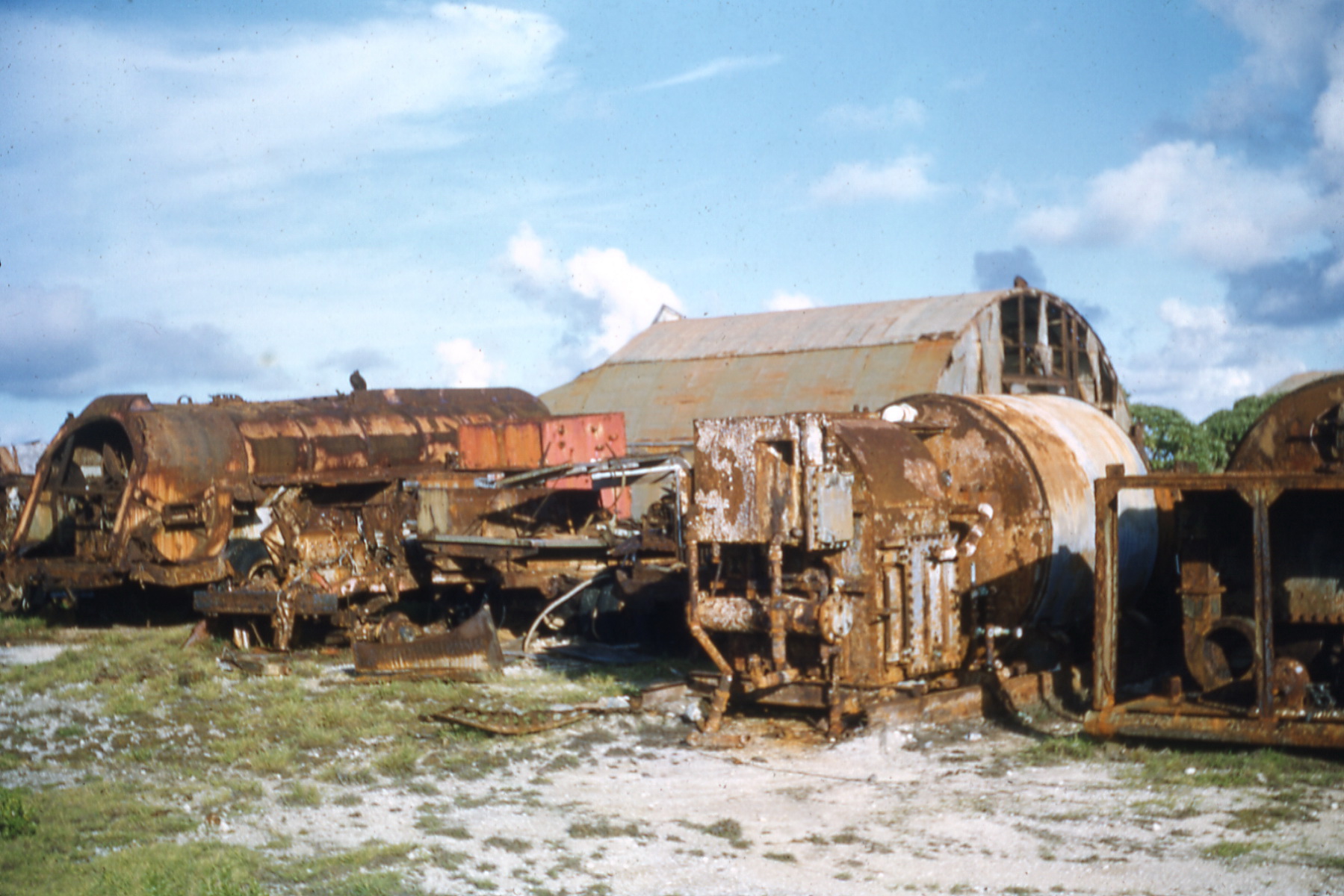
Items to be dumped [click to enlarge]
Kwajalein Island is the southernmost island of the Kwajalein Atoll. It is somewhat crescent shaped forming the southern perimeter of the atoll. The airstrip occupied about 1/3 of the island. The air terminal and Air Force quarters and facilities were located on the north-western end of the island, north of the airstrip. The Navy commissary, exchange, maintenance buildings, and the Navy enlisted clubs were located generally along the central and eastern end of the airstrip extending over to the lagoon. The island dump was located toward the western end of the airstrip on the ocean side.
There were only two east west roads on the island. One ran more or less along the lagoon and the main road along the north edge of the air strip and paralleling the ocean to the eastern end of the island. The airstrip was located on the western portion of the island occupying about 1/3 of the land surface.
The Navy headquarters, the island chapel and the Navy’s Richardson outdoor movie theatre were located east of the airstrip on the north side of the main ocean road on the island. The hospital, Navy quarters, schools (grade school and kindergarten only), pier and other facilities occupied the rest of the eastern end of the island. Senior officers’ quarters were along the ocean side of the main road across the ocean road from the headquarters buildings and chapel.
The Marine compound was located on the ocean side of the island at the eastern end of the runway. Coconut trees had been brought to the island and replanted throughout the compound area. A white picket fence set off the compound bordering the road. The barracks and other buildings showed signs of neglect and poor upkeep as most buildings on the island.
The Mid Pac construction company (an amalgamation of Morris-Knutson and two other companies) consisting of about 1000 employees had a separate compound located north of the Marine compound and east of the airstrip in the central part of the island. The manager was Dave Smith.
There was a Marshallese village on the south side of the runway with a population of about 200 people. It was considered as a workers’ village for those employed on the island. A tour of their area showed the individual family buildings to have been constructed of whatever material they were able to obtain. Most were in a rundown condition. The village was close to the airstrip and the island dump, which, no doubt, was very unpleasant for them. I do not recall how many people were living on their home island of Ebeye, just east of Kwajalein, at that time.
I don’t recall the exact date but one morning I was watching a plane taking off from the airstrip. It didn’t seem to be gaining elevation and all of a sudden it plunged into the ocean only about 2 or 3 miles from the island. The Navy sent a rescue boat out but it had to go up to Gear Pass and around the western end of the island to reach the crash site. By the time they got to the crash site there was only a few bits of floating debris. The plane was headed for Korea, and sadly to say, had a large contingent of nurses on board.
To add to the confusion of my initial days on the island an auditor arrived from FMF Pac to check the equipment/clothing inventory, Special Services equipment and the records of the Marine Club. When I relieved Captain Durham I found that all of the accounts were lacking adequate records, clothing and equipment was missing, Special Services items couldn’t be located and the records were in complete disarray, or in the case of the Club non-existent. I had signed off for the various accounts “Subject to Inventory”. Prior to the auditors arrival I had completed my inventory of the clothing and equipment accounts identifying the missing items, writing rules and regulations for the operation of the Club, which were completely lacking. But, due to lack of time, had been unable to do anything about the Special Services account. It was fortunate that I had some knowledge of club and Exchange operations from correspondence courses I had taken and serving on Audit committees in San Francisco and Camp Lejeune
Because of the way the military seems to work, I was responsible even though I had just relieved the previous CO. The only thing that saved me from being censored for the condition of these accounts was that I had accepted them “Subject to Inventory “and had initiated corrective action. As it was I had to write a rebuttal to the Auditors report that he submitted to FMF PAC He to clear my name.
I believe it was late August when Bob Hope and his USO Troop made an overnight stop on Kwajalein returning from Korea. They put on a performance at the Richardson open-air theatre attended by nearly everyone on the island. Arrangements had been made for Bob Hope, Les Brown and the starlets in his group to visit the Navy and Air Force Enlisted Clubs after their performance. I insisted that my Marine Club be included also. The visit to the Air Force Club went smoothly but the visit to one of the Navy clubs had to be cut short because some of the sailors with too much under their belts were rude in yelling “Ski nose” at Bob Hope and trying to fondle the starlets. Their actions almost caused cancellation of the visit to my club but I insisted no such behavior would take place. When we entered our little underground club, my Marines stood back and it was Bob Hope and Les Brown who went up and shook hands with them and initiated conversations. Bob took a seat, had a soft drink and spent better than an hour in a very quiet and relaxing visit. I know Admiral Ring was very embarrassed for the way his sailors had behaved but he never mentioned anything to me about it to me.
On Labor Day, Betty’s father, Dr. George D. Meeker died of a heart attack. Again, with the aid of Ray Lucked, Betty cancelled her rental agreement, and put the car in long-term storage. Betty, Rob and Susie flew back to Cincinnati for the funeral, arriving only a few hours before the service. They stayed there for about a month with Betty’s mother until Betty received word they could travel to Kwajalein.
My roommate, Stan Brent, seemed to have more free time than I did spending time snorkeling and spearing fish in the lagoon. He particularly relished catching octopus, bringing them back to our quarters, cleaning and boiling them. It didn’t take me too long to enjoy having tidbits as a snack along with a beer or other drink. Having spent some time in Hawaii, Stan also liked collecting seashells, from small cowries to larger shells like the helmets. To clean them he would suspend the larger shells, like the helmet, over a pail of water. Most of the animal would drop out seeking the water but usually part would break off and remain in the shell. As it decayed it gave off a very offensive odor noticeable from a good distance. He had no alternative but to leave them outside.
From the very beginning I found my days and nights occupied not only with getting acquainted with my Marines and setting up a much-needed training program, inventorying property and Special Services (recreational) equipment, but often touring the island at night with the Sergeant of the Guard to check on the performance of our guard force. Not many nights went by that I wasn’t called out for some type of disturbance. These varied from report of robbery, fights, drunkenness, family marital problems, threats of suicide and disturbances at the Marshallese village.
To alleviate some of the problems the Navy and Air Force placed better controls and earlier closing hours on their clubs, an agreement was made with Mudpack’s Dave Smith that their security force would enforce better control of their personnel and my Marine security patrols would enter their compound only if called on, and most importantly the Marshallese village was placed “Out of Bounds” to all non- Marshallese. This was enforced by frequent patrols.
Of course, there are always a few who test the system. A couple Mid-Pac men were caught in the Marshallese village causing a disturbance. I turned them over to Dave Smith and he immediately fired them and sent them back to Hawaii. A couple nights later I was awakened by the Sergeant of the Guard and told that a Marshallese man wanted to see me. I went to the marine compound and he in a few broken words made it evident that his wife had been assaulted and he had been robbed of, as I recall, $482.00. He said “Marine” and placed three fingers on his arm-indicating Sergeant. When I had the NCOs called out the Marshallese man pointed out the offender. In a search of the Sergeant’s room we found the $482.00 in a shoe under his bed. Needless to say, it was embarrassing thing to have one of my men commit a major crime. He was tried in a General Court Marshall, found guilty and shipped to Hawaii to serve his sentence. After these cases we never had any more problems with the Marshallese people being disturbed.
Betty, Susie, and Robby on their way [click to enlarge]
One of the guard stations was the single women’s quarters for nurses, librarians, and teachers. Naturally, with over 2500 single men, construction workers and service men, on the island the safety of the women was of paramount concern. Because of some previous problems, I instituted a program of better controls. For their security it was necessary to know their whereabouts day and night. Sometimes it became a game with some of them trying to sneak out without detection by the Marine sentry. In my over two years on the island we had no major problem with their safety. Of course, some of the women dubbed me as “Mother Hen” and some other choice expressions.
In late September Betty received notice that she and the children would travel to Kwajalein. They flew to San Francisco and again stayed at the Marine Memorial Club awaiting transportation. After a few days they embarked at the Naval Shipyard, Oakland, CA. on the Navy transport, the USS Aultman for Kwajalein, receiving first class treatment in being chauffeured by a Marine to the ship and being assigned a private stateroom, again thanks to Ray Lucked. They had a brief stop at Honolulu, Hawaii, where the Schutts greeted them. On October 26, they celebrated Susie’s 1st birthday aboard ship. All three of them received certificates, which they still have, for crossing the International Date Line.
Rob, while playing and running down the companionway on the ship, had a bad accident, hitting his head on a hatchway getting a bad cut on his left temple, requiring ten stitches When they arrived on Kwajalein his head was shaved and wrapped with a big bandage.
The USS AULTMAN was able to enter the lagoon thru Gear Pass and anchor in the lagoon to unload passengers and equipment destined for Kwajalein. I went out to the ship and collected my family and brought them to their new tropical home.
I welcomed my family into their new home. It wasn’t with pride that I showed Betty the shoddy looking house and the rusty refrigerator. Having thought a bit of humor was needed I had placed an octopus in a bowl in the rusty refrigerator, draping its tentacles decoratively in the rusty refrigerator down over the sides of the bowl. Needless to say, if there had been a ship leaving for the states they likely would have been on it.
We were able to hire a Marshallese housekeeper (Mateo) and between she and Betty they had the house cleaned up as well as could be expected in a few days.
Mateo lived on Ebeye and would come over on a Navy boat that provided daily transportation to and from Kwajalein. She often brought her son, whose name we can’t recall, with her. He was about a year or two older than our son Rob. The two boys had fun playing together. Often, Mateo would weave a ball out of palm leaves that the boys could toss to each other. Other times she would weave hats out of palm fronds. They weren’t the fine closely woven hats but were made with the wider fronds, which she could finish, in a very short while.
Neither of the boys could speak the others language but that seemed no hindrance. There was never any disagreement or lack of sharing. Amazingly, even at Rob’s age, about 3 ½, he learned some Marshallese.
Our social life began immediately with welcoming parties and dinners. Every Saturday night there was a dance at either the Air Force or Navy Club. Other times during the week bingo or some other activity would take place. We often played cards with our next-door neighbors, Bill and Katy Baronage or Roma and Ray Manner. Bill was the Civil Administrator for the UN Trust Territory assisting the Marshallese people. Ray was the Navy’s Air Operations Officer.
On Nov. 10th (1950) we celebrated the Marine Corps Birthday with the traditional reading of the Commandant’s message, the cutting of the cake with my sword and a picnic.
One of the first events we attended with the Marshallese people was the launching of a Marshallese sailing ship, which had been converted from a Navy motorboat. Marshallese workmen had converted the boat into a sailing vessel. The ship was lifted off its cradle by a crane and with nearly everybody present pushing or pulling on ropes the ship was guided into the lagoon. All of the Marshallese people were dressed in very colorful clothes wearing there beautifully hand woven hats. Soft drinks, cookies, and doughnuts were served. The doughnuts were huge. They were served by placing them over the neck of the coke bottle.
The same day another Navy motorboat, transferred to the Marshallese people, was hoisted onto a cradle (stand) on land so the native workers could modify it into another sailing vessel.
Net Fishing [click to enlarge]
While this ceremony was going on I noticed a Marshallese man net fishing nearby in the lagoon. I couldn’t pass the opportunity to not take a few pictures of his success. It was interesting to see how unhurried, tolerant and methodical he was. Several casts he came up empty handed but he’d just gather in his net and recast it until he had a good catch.
Periodically, over the next several weeks, I’d drive by to see how the conversion to the sailing vessel was progressing. I was entranced seeing one of the workers using a machete to shape a wooden fitting to be inserted on the leading edge of the keel. With all of our tools I don’t think a neater fit could have been made.
1951
On August 11, 1951, the Marine Barracks was redesignated Marine Detachment, U.S. Naval Station, Navy #824.
1952
In February 2020 we found a letter from Major Thompson written just before the family left Kwajalein.
